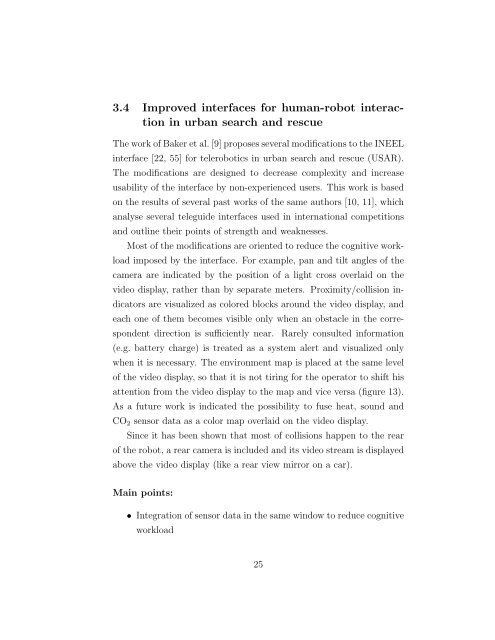Scarica (PDF – 6.19 MB)
Scarica (PDF – 6.19 MB)
Scarica (PDF – 6.19 MB)
Create successful ePaper yourself
Turn your PDF publications into a flip-book with our unique Google optimized e-Paper software.
3.4 Improved interfaces for human-robot interaction<br />
in urban search and rescue<br />
The work of Baker et al. [9] proposes several modifications to the INEEL<br />
interface [22, 55] for telerobotics in urban search and rescue (USAR).<br />
The modifications are designed to decrease complexity and increase<br />
usability of the interface by non-experienced users. This work is based<br />
on the results of several past works of the same authors [10, 11], which<br />
analyse several teleguide interfaces used in international competitions<br />
and outline their points of strength and weaknesses.<br />
Most of the modifications are oriented to reduce the cognitive work-<br />
load imposed by the interface. For example, pan and tilt angles of the<br />
camera are indicated by the position of a light cross overlaid on the<br />
video display, rather than by separate meters. Proximity/collision in-<br />
dicators are visualized as colored blocks around the video display, and<br />
each one of them becomes visible only when an obstacle in the corre-<br />
spondent direction is sufficiently near. Rarely consulted information<br />
(e.g. battery charge) is treated as a system alert and visualized only<br />
when it is necessary. The environment map is placed at the same level<br />
of the video display, so that it is not tiring for the operator to shift his<br />
attention from the video display to the map and vice versa (figure 13).<br />
As a future work is indicated the possibility to fuse heat, sound and<br />
CO2 sensor data as a color map overlaid on the video display.<br />
Since it has been shown that most of collisions happen to the rear<br />
of the robot, a rear camera is included and its video stream is displayed<br />
above the video display (like a rear view mirror on a car).<br />
Main points:<br />
• Integration of sensor data in the same window to reduce cognitive<br />
workload<br />
25




